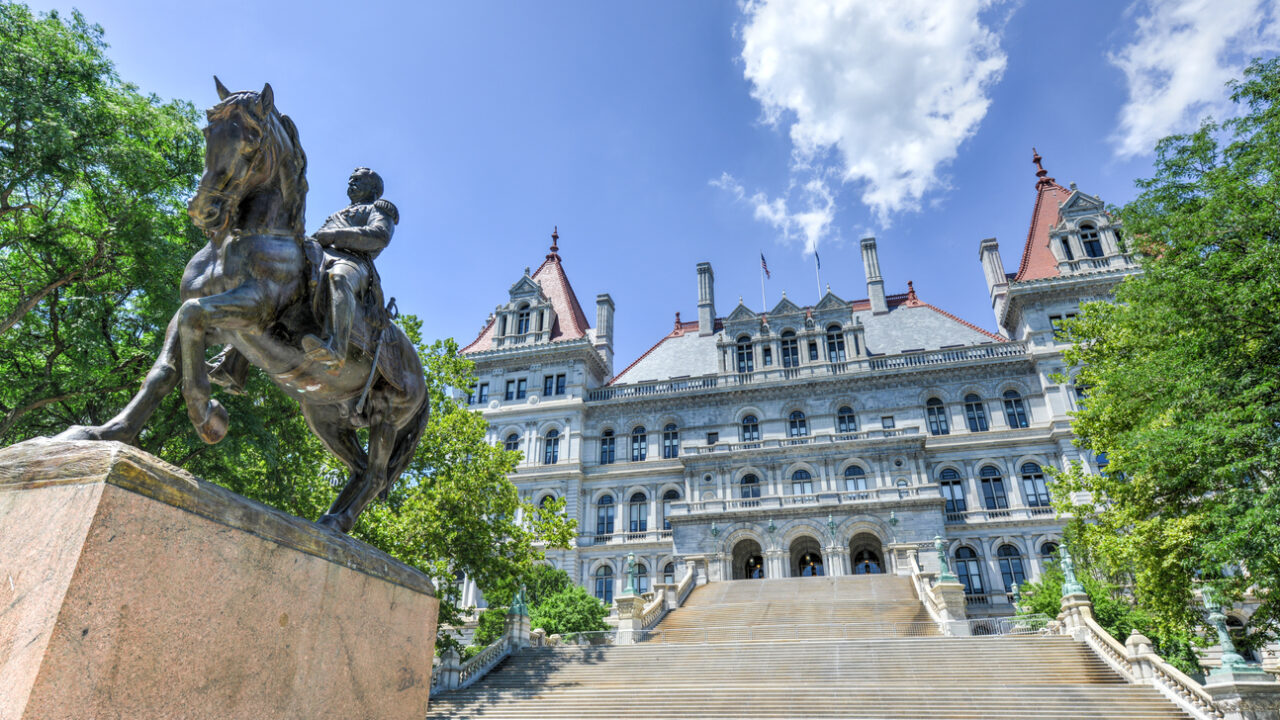In April of this year, New York State increased both the personal income tax rates on high earners and the corporate tax rate, which together will yield $4.3 billion in new progressive revenue annually. With that new revenue, the legislature made historic investments in public education and housing relief. It also created a first-in-the-nation fund for “excluded workers,” the mainly undocumented New Yorkers who had received no money from successive rounds of federal COVID relief after having absorbed much of the risk and suffering of the pandemic. This huge victory for working-class New Yorkers, which was won despite the dogged opposition of former Governor Andrew Cuomo, demonstrates the on-the-ground impact of progressive co-governance.
These investments were made possible by a broad coalition of organizers and progressive legislators who had been working together for years to pass legislation to tax the rich. The Invest in Our New York (IONY) coalition’s steering committee was made up of the New York Working Families Party (NYWFP), where we serve as Director and Deputy Political Director, respectively; community organizations (many of them NYWFP affiliates), including Citizen Action of NY, Make the Road NY, New York Communities for Change, and VOCAL-NY; Empire State Indivisible; the New York City chapter of the Democratic Socialists of America; Strong Economy for All; Alliance for Quality Education; and Housing Justice for All.
The pandemic gave us the narrative opportunity to fight for a bold package — $50 billion in new revenue without any ties to expenditures — and to frame it as the way for the state to recover from the challenges of 2020 and build back even stronger. We made the difficult decision to fight for revenue only (rather than tying revenue bills to specific expenditures), in essence “growing the pie” rather than fighting each other for crumbs.
Year after year, the Governor would pit us against each other on expenditures; this year, we wanted to fight for revenue collectively rather than in silos. As a result, our campaign mounted so much unified pressure on legislators that it served as a genuine litmus test to see which legislators were willing to be courageous on the priority progressive issue, provided enough common ground for electeds across different regions and spaces to work together, and gave coalition members a sense of collective power as we moved legislation forward.
As coalitions and movements far and wide explore co-governance, the IONY coalition’s success in increasing taxes on corporations and the wealthy offers key lessons about how to run an inside-outside strategy rooted in building governing power.
How We Got Here
The New York Working Families Party was founded in 1998 to challenge the rightward drift of Democrats in New York and nationally. Our electoral infrastructure is co-owned by parts of organized labor, power-building community organizers, and left activists across the state. NYWFP has built a track record of effective electoral interventions and of translating those electoral interventions into policy victories, including increasing the minimum wage, rolling back draconian drug laws, increasing taxes on the rich, and establishing universal paid sick leave benefits.
NYWFP had long been in a state of intense antagonism with Cuomo, especially over his pursuit of tax cuts for the rich and budget cuts for everyone else; his enthusiasm for school privatization and hydraulic fracking; and his slow-walking of popular and badly needed measures, such as a $15 minimum wage, paid family leave, and public financing of elections. Most critically, the Governor lent quiet support to a breakaway caucus of Democrats in the State Senate (the so-called Independent Democratic Conference, or IDC) who voted to give Republicans control of the chamber in exchange for campaign donations and petty perks.
In 2018, we succeeded in destroying the IDC by defeating six out of eight conference members in primaries, in each case replacing conservative incumbents with strong progressives (though we were unsuccessful in our effort to topple Cuomo). Many of these progressive champions, along with others whom WFP had worked to elect over many years, led the charge in demanding accountability from the Governor for his cover-up of nursing home deaths, ethics violations, and, of course, a grotesque pattern of sexual harassment and intimidation.
NYWFP, our affiliates, and our allies (including the NYC chapter of the Democratic Socialists of America) believed that primary elections in June 2020 would be critical to defeating Cuomo’s austerity agenda. Coming only weeks after the horrific first wave of COVID and the uprisings that followed the state’s murder of George Floyd, voters chose progressive challengers in race after race.
In November, WFP candidates flipped a number of Republican seats in the State Senate, giving Democrats in that chamber a veto-proof supermajority to match the one in the Assembly. Critically, the NYWFP also decisively overcame a shameless attempt by Cuomo to destroy the party by more than doubling the number of votes we needed to retain our ballot line. With the new rules, WFP needed to receive roughly 170,000 votes (or two percent of the total statewide vote) for Joe Biden and Kamala Harris on the WFP line; in the end, the total was more than double that. That campaign for our ballot line, which prominently featured the demand to tax the rich, helped to create the conditions for our campaign.
These electoral victories shifted the balance of power in Albany in both visible and less visible ways. No one could miss the diverse cohort of young, staunchly progressive (indeed, in several cases, openly socialist) new members of the Legislature. But electoral victories in Rochester also showed the impact that long-term power- and coalition-building and smart electoral strategy can have on governing. Rochester-area seats had long been split between Republicans and Democrats; the “swing” quality of many of the districts meant that the area’s Democrats were among the more conservative members of their caucuses. In several primaries for open seats, progressives backed by WFP and local community groups won. In the general election, two of those progressives flipped Republican-held State Senate seats. In one election cycle, Rochester went from “swing” turf to an area almost entirely represented by WFP champions.
But the electoral outcome itself was not enough to bring about a victory for progressive governance. The reality is that Republicans remain competitive in some seats, exercising a moderating pull on some of the members. The Invest in Our New York coalition worked to make sure the new Rochester delegation was on board with our ambitious suite of revenue raisers: by asking one of the members to carry a revenue bill, by leaning on the deep relationships of trust that were forged through their election campaigns, and by enlisting the local Rochester organizations that have been building power together for a decade or more, many of whose leaders are active in the Rochester chapter of the WFP.
With these organizations, we mobilized hundreds of folks to testify at a Rochester budget hearing. We followed up with inside tactics (one-on-one calls and friendly lobby meetings from our leaders, staff, and allies in labor) and outside tactics (door hangering, rallies, protests, and press conferences). Ultimately, we moved the entire delegation to support our bills.
Building a Winning Coalition
One of the key interventions that the IONY political committee made was to create a “circle of champions” who met weekly to share information and craft a strategy for winning majorities for our revenue proposals. The IONY circle consisted of 30 or so regular legislative participants (including several whose participation may have surprised others) and operated in broad daylight (despite the known opposition of the powerful Assembly Speaker to our bills) — a closer, better coordinated, and more productive working relationship between advocates and progressive legislators than has been typical in Albany.
Things did not always run smoothly, and trust took time to build, but the size and cohesion of the circle of champs helped demonstrate to Assembly and Senate leadership that there was a significant bloc of legislators who were absolutely serious about passing progressive revenue measures despite the Governor’s opposition. Along with a strong outside game of phone banks, door hangers, and direct actions; a clear and compelling narrative; and highly effective press work, IONY’s legislative organizing was a critical piece of the campaign’s success.
The challenges, of course, were significant. Even when we shared an ideological alignment, conflicts emerged around priorities, tactics, and relationships to leadership, to name just a few. There were also questions of governance: NYWFP and our affiliates and allies came to legislators with requests or demands, but our campaign strategy was largely determined by the outside. Legislators did not have a formal role in shaping our campaign strategy, nor did they have a role in larger NYWFP party-building and decision-making. This meant our campaign strategy was not maximally informed by all stakeholders, and there was not always full alignment between inside and outside on what tactics were sanctioned by our strategy.
There were also challenges around capacity: our organizations are not built to cohere groups of legislators around shared strategy and priorities, to institutionalize governance relationships between them and us, or to provide mentorship and leadership development to the people we elect. To meet these critical needs, we need to not only increase staff capacity but also develop a shared theory of change around co-governance and address alignment gaps within our larger movement. Co-governance represents an evolution in our organizing model that will bring challenging conversations. Many of our affiliates and allies are used to being the outsider, and there is resistance to relinquishing that model for fear of mission drift, co-optation, and more. As we gain more champions on the inside, we must reckon with the fundamental question of how the left governs. We also must resource and build this critical infrastructure, whether it’s policy staffers who drive our understanding of what’s possible, a deep bench of aligned administrators who can implement our policies and navigate bureaucracy, public narrative campaigns that sell our victories, or organizing efforts to bring more constituencies into our bloc. This is work that is not always as glamorous as high-profile electoral or legislative campaigns, but is absolutely critical to govern.
We are beginning to see the way forward and are hopeful about where it will lead. As organizers, activists, and elected officials struggle to co-govern, we’ve pulled out some key takeaways from this past year’s efforts.
-
Budgets aren’t borne of objective truths. Budgets are often presented as mere statements of fact when they are intensely political. Budgets reflect interests, values, and politics, not just in terms of their funding priorities but also in terms of revenue projections and cost projections. They can be used to preemptively rule out possibilities, outcomes, and courses of action, defining what is viewed as possible and what is dismissed as fantasy. Throughout the campaign, we were told to wait for official numbers from the legislature when we knew the team coming up with the numbers had a specific political perspective on austerity budgeting. Pushing values to counter “facts” leaves you out of the conversation, especially when one political actor has a monopoly on what is considered a fact. We worked on policy documents to make the case for our $50 billion revenue package, but we could have done more. Rather than wait for the legislature to ask for our numbers, we needed to launch our campaign with economic modeling that demonstrated the need behind them. Breaking up the monopoly of information that leadership and the administration closely guard would expand the public’s sense of what is possible and put a wider array of revenue raisers (such as wealth taxes) on the table rather than allowing the legislature to revert back to what it knows and has always done (progressive income taxes).
-
Data matters. Polling by Data for Progress, which appeared intermittently throughout the campaign, provided much-needed cover for legislators by showing that our positions were hugely popular. The polling also helped us expand the coalition, gave confidence to our legislative allies, and kept our opponents on their back feet.
-
Create spaces of shared strategy. We struggled with how broad to make our circle of champs and ultimately settled on a big tent with a clear goal and open meeting format. Legislators often don’t trust each other, so the coalition decided to be transparent, inviting, and affirming in our organizing. The Democratic Conference is often described as a space of performance, puff, protest, and disengagement, not shared strategy. Therefore, it was critical to create another space where legislators and movement allies could actually strategize and organize—discuss tactics, take assignments, and share concerns and information transparently.
-
Invest in and organize your crew. We are a coalition of key power-building organizations that have long worked together in informal and formal structures. While we may share a vision for the state, our individual organizational cultures, analyses, strategies, and tactics sometimes differ. We had to work hard at alignment, and at times struggled over when and how to escalate the pressure on elected officials, specifically around direct actions at legislators’ residences. We expected leadership and/or opposition to try to divide our crew by dangling funding, threatening to cut off access to electeds, or other forms of coercion. The IONY Steering Committee was able to resist this pressure because the coalition was co-owned and accountable. Many of IONY’s organizations play primarily or exclusively outsider roles in our movement. They agitate, protest, and escalate to generate pressure that forces legislators to act. As an electoral organization that has close relationships with electeds, the Working Families Party negotiated the inside and outside relationships and dynamics. There is trust in the party’s ability to play that role because of our electoral power and the infrastructure we’ve developed to recruit candidates and launch, staff, and win campaigns.
Our effective coordination with legislative champions during the revenue fight shows the enormous potential that exists in co-governance while highlighting some of the challenges we will inevitably face as we pursue it. Our hope is that we can continue to increase the ranks of progressive champions through our electoral work, bring greater coherence and structure to that bloc of progressive legislators, and formalize or perhaps even institutionalize the relationship between that bloc of progressive legislators, the NYWFP, and our affiliates. If we can take steps in that direction, we will be close to achieving true governing power in New York State.
Another New York is possible. We’re catching glimpses of it and organizing to make it a reality.


